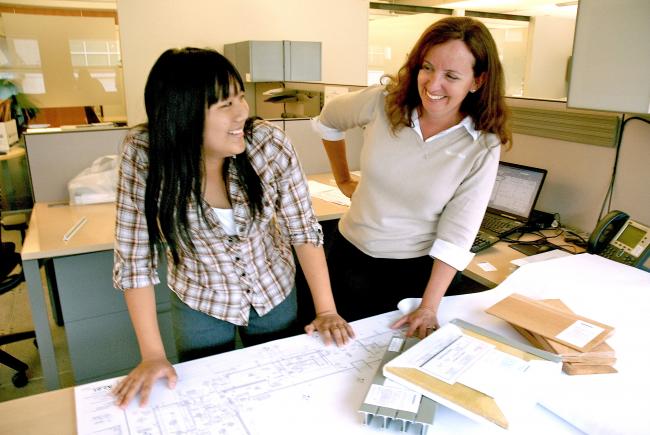Constructive summer for WSHS sophomore at Skanska, Inc.
BLUEPRINT FOR SUCCESS. West Seattle High School, 15 year-old Michiko Yoshino, a High Point resident, was hired as a paid summer intern with Skanska. Her supervisor, Kris Beason, Skanska Project Executive and Special Projects Division Head, said it was the company that hit the jackpot when the motivated teen clocked in.
Tue, 09/07/2010
Just out of her freshman year at West Seattle High School, 15 year-old Michiko Yoshino, a High Point resident, was hired as a paid summer intern with Skanska USA Building, Inc., the Swedish-based construction and project development company, at 221 Yale Avenue North in downtown Seattle.
Although Yoshino said she felt fortunate to be chosen for the position, her supervisor, Kris Beason, Skanska Project Executive and Special Projects Division Head, said it was the company that hit the jackpot when the motivated teen clocked in.
The two met at a jobs fair sponsored by the YWCA’s Girls First Program. Beason has volunteered for the YWCA, and Skanska has done renovation projects for them.
According to its website, “The mission of YWCA GirlsFirstSM is to encourage leadership, instill confidence, develop skills, and provide opportunities to girls of color (…) Our program includes a three-week Summer Leadership Academy, weekend overnight retreat at Seattle University, weekly afterschool sessions, and monthly Leadership in Action Days. Alumnae opportunities include mentoring, tutoring, and paid summer internships.”
“We didn’t really know what to expect,” said Beason, who was raised in West Seattle and attended Lafayette and Hope Lutheran schools. “We were talking to a lot of young ladies at the career fair which was great for me being in this industry 25 years, five with Skanska. The more I talked, the more they got interested in this career.
“I was surprised how hard Michiko worked, her dedication. She was a quick study and far exceeded all our expectations, definitely a very impressive young lady. She’s always saying ‘I need more to do’ and works faster than some of our regular employees.”
Some of Skanska’s 53,000 employees worldwide have developed such marquis projects as London’s Heron Tower and New Jersey’s new Meadowlands Stadium.
Back at home they were recently awarded a $114.6 million construction contract on the first segment of the Alaskan Way Viaduct replacement project on South Holgate. (The company was awarded the contract because of its low bid, and its position is the city will benefit from this segment regardless of the outcome of the deep-bore tunnel, controversial to some.)
“I was looking for a summer internship so I attended the job fair,” said Yoshino, who was born in Tokyo and has a Vietnamese background. “There were five or six companies there with booths, like the Puget Sound Blood Center, Foundation for Early Learning, and the Seattle Art Museum.”
She feels happy she got in with Skanska.
“I have worked in the office and toured our job sites,” she said. “The construction workers were pretty much male dominated,” she added.
Yoshino worked on the Casey Family Programs new headquarters building. Casey is named for Seattle’s UPS founder, James Casey. The building is set to achieve the “Living Building Challenge,” the first in the state. This means its specifications would exceed Lead Platinum, a very high environmental standard encompassing sustainable practices.
She also worked on the news Science Class addition to Bertschi Elementary School on Capitol Hill, which is up for Lead Gold certification. Skanska’s website states it prides itself in green building and has won awards for building sustainability.
While Yoshino was out on the job sites, most of her work for Skanska was done in their offices.
“I worked on the construction computer program that measures flooring, ceiling, and wall areas,” said Yoshino.
“She has more knowledge of this program now than other employees here,” said Beason with pride. “Michiko was given a floor plan with the layout of enclosed offices surrounding the open (central) office area and with this program could determine ceiling height, wall measurements, and floor types, all highlighted in different colors.”
“Every morning all the employees have a stretch and flex routine, kind of an aerobic warm-up for the rest of the day,” said Yoshino. “It’s really cool.”
The practice originated in Seattle and now is a U.S. companywide practice. The idea is to promote a positive mindset, followed up by pre-task planning, to think through actions employees are about to undertake, mentally walking through risk to minimize it.
Beason is all about getting females into traditional male careers.
“This year I am president of Commercial Real Estate Women, or ‘CREW,’ and ‘CREW Careers’ reaches out to Girls First, to JA (Junior Achievement,) Girl Scouts, and brings in high school students to teach about commercial real estate and the benefit of going into that non-traditional (women’s) career,” said Beason.
“I want young women to realize construction is a really good industry to work in, that there is a lot of benefit to working in this industry. You don’t sit at a desk all the time. You go to the job site, and you are also always learning something new. The technology is always changing and evolving. It’s a great fit if you’re the personality type that likes to continue learning.”
Yoshino actually took a “vacation” during her summer internship to Japan through a YMCA leadership program. She was surprised by some of the construction she saw in big cities there.
“They use different construction materials,” she said. Here buildings look more colorful and vibrant.”


